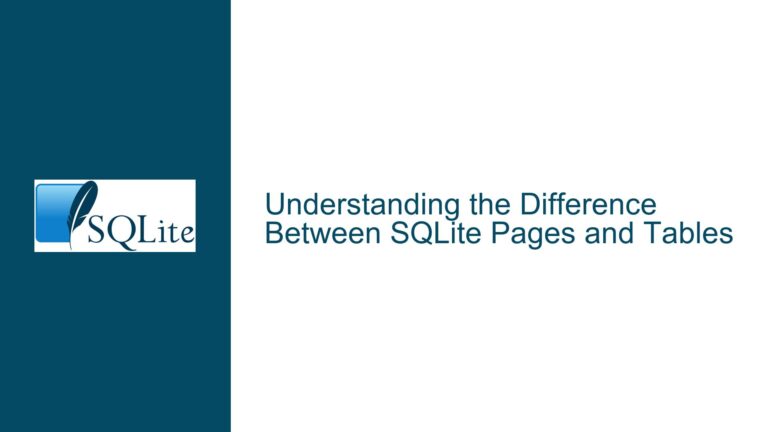Handling Media-Specific Lists in SQLite Without Triggers
Managing Media-Specific Lists with Foreign Key Constraints
The core issue revolves around designing a database schema that supports creating and managing lists specific to different media types (e.g., movies, TV shows, books, comics) without relying on triggers. The challenge is to enforce referential integrity using foreign keys while ensuring that lists are media-specific and can be extended to accommodate new media types in the future. The current schema struggles with this because it either requires duplicating tables for each media type or using triggers to enforce constraints, which the user explicitly wants to avoid.
The problem is further complicated by the need to maintain unique list names within each media type and to ensure that lists cannot contain items from incompatible media types. For example, a list created for movies should not allow TV shows to be added to it, and vice versa. The user also wants to avoid redundancy in the schema, such as creating separate tables for each media type’s lists, which could lead to confusion and scalability issues as more media types are added.
Foreign Key Limitations and Schema Design Challenges
The primary cause of the issue lies in the limitations of SQLite’s foreign key implementation. SQLite does not support multi-column foreign keys that reference a combination of columns in another table. This limitation makes it difficult to enforce constraints where a list must be specific to a particular media type. For example, if a list table has a composite unique constraint on (mediatype, id), SQLite cannot directly enforce a foreign key constraint that references both columns simultaneously.
Another challenge is the need to maintain unique list names within each media type. If the list table uses a composite unique constraint on (mediatype, name), it becomes difficult to reference this combination in child tables like movie_list or tv_list using foreign keys. This limitation forces the user to either duplicate tables for each media type or use triggers, which they want to avoid.
Additionally, the schema must be scalable to accommodate new media types without requiring significant changes. The current approach of creating separate tables for each media type’s lists (e.g., list_movie, list_tv) is not scalable and can lead to confusion as more media types are added. A more elegant solution is needed to handle this complexity while maintaining referential integrity and avoiding redundancy.
Schema Refactoring and Foreign Key Workarounds
To address these challenges, the schema can be refactored to use a single list table with a mediatype column to distinguish between different media types. This approach avoids duplicating tables for each media type and ensures that lists are uniquely named within their respective media types. The mediatype column can be used in combination with the id column to enforce referential integrity using foreign keys.
Here is the refactored schema:
CREATE TABLE media_type (
id INTEGER PRIMARY KEY,
name TEXT UNIQUE NOT NULL
);
CREATE TABLE list (
id INTEGER PRIMARY KEY,
mediatype_id INTEGER NOT NULL REFERENCES media_type(id),
name TEXT NOT NULL,
UNIQUE(mediatype_id, name)
);
CREATE TABLE movie (
id INTEGER PRIMARY KEY,
title TEXT NOT NULL
);
CREATE TABLE tv (
id INTEGER PRIMARY KEY,
title TEXT NOT NULL
);
CREATE TABLE movie_list (
movie_id INTEGER NOT NULL REFERENCES movie(id) ON DELETE CASCADE,
list_id INTEGER NOT NULL REFERENCES list(id) ON DELETE CASCADE,
UNIQUE(movie_id, list_id)
);
CREATE TABLE tv_list (
tv_id INTEGER NOT NULL REFERENCES tv(id) ON DELETE CASCADE,
list_id INTEGER NOT NULL REFERENCES list(id) ON DELETE CASCADE,
UNIQUE(tv_id, list_id)
);
In this schema, the media_type table stores the different media types (e.g., movie, TV show, book, comic). The list table includes a mediatype_id column that references the media_type table, ensuring that each list is associated with a specific media type. The UNIQUE(mediatype_id, name) constraint ensures that list names are unique within each media type.
The movie_list and tv_list tables reference the list table using a foreign key on list_id. This approach ensures that each list is specific to a particular media type without requiring separate tables for each media type’s lists. The UNIQUE(movie_id, list_id) and UNIQUE(tv_id, list_id) constraints ensure that each media item can only be added to a list once.
To enforce that only the correct media type can be added to a list, the application logic must ensure that the mediatype_id of the list matches the media type of the item being added. While this enforcement cannot be done directly using foreign keys, it can be implemented in the application layer or using check constraints if necessary.
This schema is scalable and can accommodate new media types by simply adding a new entry to the media_type table. The list table remains unchanged, and new join tables (e.g., book_list, comic_list) can be created as needed to support additional media types.
By refactoring the schema in this way, the user can achieve their goal of managing media-specific lists without relying on triggers or duplicating tables for each media type. The use of a single list table with a mediatype_id column simplifies the schema and ensures that lists are uniquely named within their respective media types. The foreign key constraints in the join tables maintain referential integrity, and the application logic ensures that only the correct media type can be added to each list.
This approach provides a clean and scalable solution to the problem, allowing the user to manage media-specific lists efficiently while avoiding the pitfalls of trigger-based solutions or redundant table structures.






